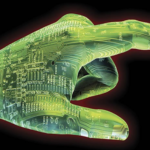News, Bioinspired Robotic Finger Advances Prosthetics Technology
Most robotic parts used today are rigid, have a limited range of motion and don’t really look lifelike. Inspired by both nature and biology, a scientist from Florida Atlantic University has designed a novel robotic finger that looks and feels like the real thing. In an article recently published in the journal Bioinspiration & Biomimetics, Erik Engeberg, Ph.D., assistant professor in the Department of Ocean and Mechanical Engineering within the College of Engineering and Computer Science at FAU, describes how he has developed and tested this robotic finger using shape memory alloy (SMA), a 3D CAD model of a human finger, a 3D printer, and a unique thermal training technique.
Learn about our two Decals!
 Click here to find out more about our Fall Bioinspired Design Decal and our Spring Bioinspired Design in Action Decal – ALL MAJORS are welcome.
Click here to find out more about our Fall Bioinspired Design Decal and our Spring Bioinspired Design in Action Decal – ALL MAJORS are welcome.Berkeley BioDesign Community
 Click here to learn about the BioD: Bio-Inspired Design @ Berkeley student organization or here to signup for more info.
Click here to learn about the BioD: Bio-Inspired Design @ Berkeley student organization or here to signup for more info.Search
Student Login




I imagine that the neurological circuits underlying these processes are governed by both 2d spacing maps with their brains as…
to reduce the impact of car accidents, it may be possible to study the force diverting physics of cockroaches to…
you see this type of head-bobbing stability in many avian creatures related to pigeons like chickens. the head ability to…
not like they taught horses how to run! this is an example of convergent evolution where both sea creatures and…
The brain functions in a similar way with neuronal connections. our brains are able to utilize the multiplicity of connections…